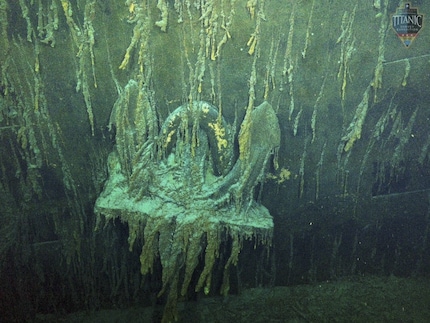
Shudderingly beautiful footage of the Titanic
The luxury tourism company OceanGate offers dives to the wreck of the Titanic for 250 000 US dollars. Last week, it released new photo and video footage showing detailed views of the ill-fated ship.
3780 metres under water lies the wreck of the Titanic. Wealthy tourists can go on a dive in a small submarine to visit the ship for 250,000 dollars. Last week, the provider OceanGate published new footage of such tours. Footage shows ghostly scenes in high quality. For the first time, videos in 8K resolution are included.
With the wreck providing little new scientific insight, there are no longer any publicly funded missions, OceanGate president Stockton Rush tells the New York Times. To continue exploring the Titanic anyway, the company plans several private expeditions each year, it writes on its website. In a video, it touts exclusivity for the 8-day luxury expeditions: "Fewer people have been to the wreck of the Titanic than have been to outer space." OceanGate adheres to strict UNESCO guidelines and does not touch or damage anything. There are nevertheless certain ethical concerns, as some experts consider the site a graveyard.

Source: OceanGate
"Cheaper than space tourism"
OceanGate guests descend to the wreck in a small submarine, taking 90 minutes to reach it. Once down, they get to watch as the crew of scientists spend three hours exploring the ship, which has been broken in two. They pursue different goals depending on the mission - scanning the Titanic with sonar and laser equipment and collecting image material. To ensure that the exclusive guests feel comfortable during the dives, the submarine is "comfortable and well lit". Commenting on the price, which is prohibitive for ordinary mortals, President Rush says: "It's a fraction of what it costs to go into space. For us to get to these ships is very expensive."
The Titanic is probably the most famous ill-fated ship in history. She collided with an iceberg southeast of Newfoundland on her maiden voyage on 14 April 1912 and sank 40 minutes later. Over 1500 people lost their lives, around 700 survived. The story of the Titanic was made into a film in 1997 - starring Kate Winslet and Leonardo DiCaprio. Because of the tragic circumstances and the high number of victims, it still exudes great fascination today. Her wreck was found in 1985. It stands upright in two parts on the seabed. The front part is well preserved, the rear part was badly damaged when it hit the seabed. Certain artefacts, such as imposing chandeliers, remained virtually intact.
.
My fingerprint often changes so drastically that my MacBook doesn't recognise it anymore. The reason? If I'm not clinging to a monitor or camera, I'm probably clinging to a rockface by the tips of my fingers.
From the latest iPhone to the return of 80s fashion. The editorial team will help you make sense of it all.
Show all